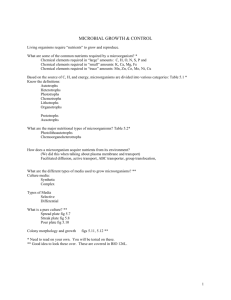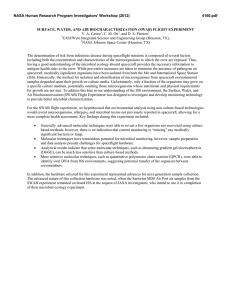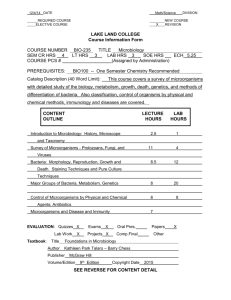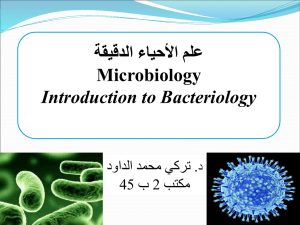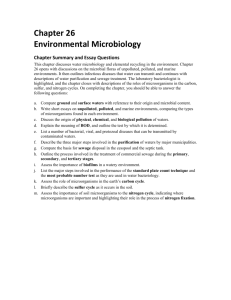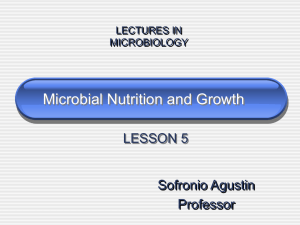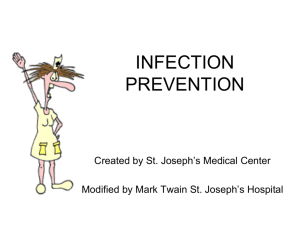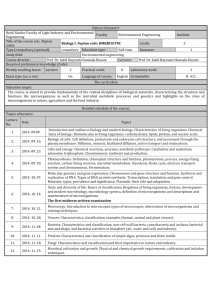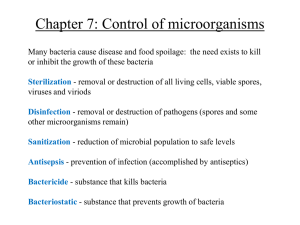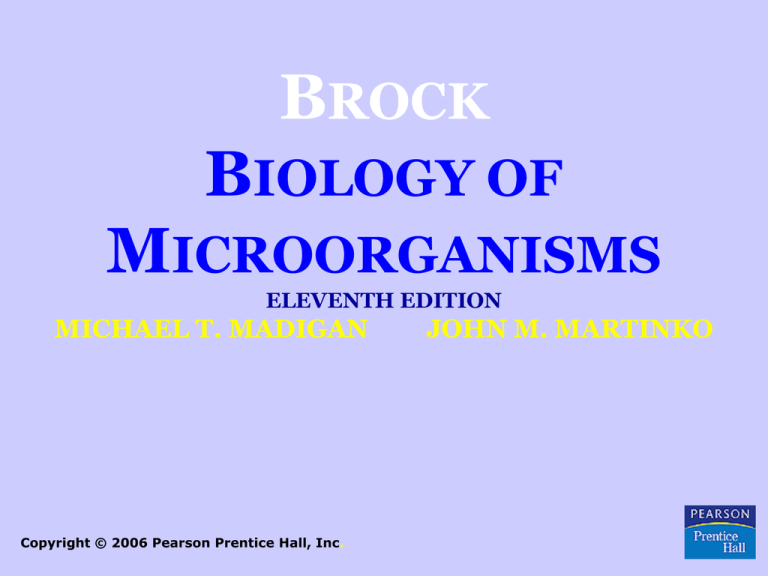
BROCK
BIOLOGY OF
MICROORGANISMS
ELEVENTH EDITION
MICHAEL T. MADIGAN
Copyright © 2006 Pearson Prentice Hall, Inc.
JOHN M. MARTINKO
The Tree of Life
• Comparative ribosomal RNA sequencing
has defined the three domains of life:
Bacteria, Archaea, and Eukarya.
Prokaryotic Diversity
• Several lineages are present in the domains
Bacteria and Archaea, and an enormous
diversity of cell morphologies and
physiologies are represented there.
Cell Structure
• Two structural types of cells are recognized:
the prokaryote and the eukaryote.
Prokaryotic cells have a simpler internal
structure than eukaryotic cells, lacking
membrane-enclosed organelles.
Bacterial Morphology
• Some typical bacterial morphologies include
coccus, rod, spirillum, spirochete,
appendaged, and filamentous.
Cytoplasmic Membrane
• The cytoplasmic membrane is a highly
selective permeability barrier constructed of
lipids and proteins that forms a bilayer with
hydrophilic exteriors and a hydrophobic
interior.
• The major function of the cytoplasmic
membrane is to act as a permeability barrier,
preventing leakage of cytoplasmic
metabolites into the environment.
Cell Wall
• Gram-negative Bacteria have only a few
layers of peptidoglycan , but gram-positive
Bacteria have several layers.
• In addition to peptidoglycan, gram-negative
Bacteria contain an outer membrane
consisting of lipopolysaccharide (LPS),
protein, and lipoprotein.
Cell Growth
• Microbial growth involves an increase in
the number of cells. Growth of most
microorganisms occurs by the process of
binary fission.
• Microbial populations show a characteristic
type of growth pattern called exponential
growth.
The Growth Cycle
• Microorganisms show a characteristic growth pattern
when inoculated into a fresh culture medium.
Environmental Effects on
Microbial Growth
Temperature
• Temperature is a major environmental factor
controlling microbial growth. The cardinal
temperatures are the minimum, optimum,
and maximum temperatures at which each
organism grows.
• Microorganisms can be grouped by the
temperature ranges they require.
Low or High pH
• The acidity or alkalinity of an environment
can greatly affect microbial growth.
• Organisms that grow best at low pH are
called acidophiles; those that grow best at
high pH are called alkaliphiles.
• Some organisms have evolved to grow best
at low or high pH, but most organisms grow
best between pH 6 and 8. The internal pH of a
cell must stay relatively close to neutral even
though the external pH is highly acidic or
basic.
Salinity
• Some microorganisms (halophiles) have
evolved to grow best at reduced water
potential, and some (extreme halophiles)
even require high levels of salts for growth.
Oxygen
• Aerobes require oxygen to live, whereas
anaerobes do not and may even be killed by
oxygen.
• Facultative organisms can live with or
without oxygen. Aerotolerant anaerobes can
tolerate oxygen and grow in its presence even
though they cannot use it.
• Microaerophiles are aerobes that can use
oxygen only when it is present at levels
reduced from that in air.
• Special
techniques are
needed to grow
aerobic and
anaerobic
microorganisms.
Toxic Forms of Oxygen
• Several toxic forms of oxygen can be
formed in the cell as the result of respiration,
but enzymes are present that can neutralize
most of them. Hydrogen peroxide is one of
those forms that can be neutralized by
catalase.
• Several toxic forms of oxygen can be formed in
the cell as the result of respiration, but enzymes
are present that can neutralize most of them.
Hydrogen peroxide is one of those forms that
can be neutralized by catalase.
Measuring Microbial Growth,
Direct Counting
• Growth is measured by the change in the
number of cells over time. Cell counts done
microscopically measure the total number of
cells in a population, whereas viable cell
counts (plate counts) measure only the living,
reproducing population.
Indirect Counting
• Turbidity measurements are an indirect but
very rapid and useful method of measuring
microbial growth. However, to relate a direct
cell count to a turbidity value, a standard
curve must first be established.


